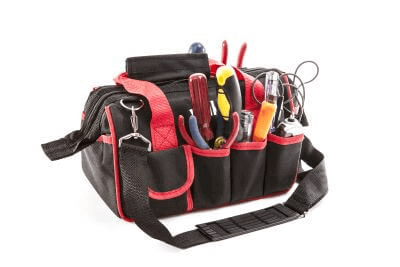What Is a Tool Bag?

A tool bag is a special bag for storing small tools, such as power tools, screwdrivers, and other small items.
By storing tools that do not fit into a hip tool belt, they can be quickly retrieved when needed and also reduce the weight of the tools on the hip tool.
Tool boxes are available as tools for storing tools, but since they are heavy and difficult to carry, a tool bag is useful in the field where there is frequent travel. In addition, a tool bag made of soft case material will not damage the construction materials and supplies on site.
Uses of Tool Bags
Tool bags are not only used for transporting tools and other materials to the job site, but may also be used for storing tools directly in the bag after use.
Tool bags are also used for storing pre-determined tools in order to save time and effort in loading and unloading necessary tools each time they are transported, or to prevent forgetting necessary tools.
Types of Tool Bags
Some tool bags have dividers and zippers for easy organization, while others are genuine tool bags that fit tools neatly. Genuine tool bags are used to store and transport expensive or fragile items, such as power tools and precision instruments.
Tool bags come in a wide variety of sizes, from small pouch-type bags that wrap around the waist to hold relatively small and frequently used tools such as screwdrivers and wrenches and can be worn on site, to large tool bags with wheels. In general, they are often used to carry tools close to where they will be working on a construction site.
A tool box is a container similar to tool bags, but since a tool box is a box and therefore difficult to carry, tool bags made of flexible cloth are more suitable for carrying tools over long distances.
How to Choose Tool Bags
Tool bags come in a variety of sizes and functionalities, so choose one that is appropriate for your work environment, taking into consideration how often you will need to carry it, how often you will need to open and close it, and other factors. Also, check for safety features such as load capacity and whether there is a mechanism (e.g., zipper) to prevent tools from popping out of the bag. The following is a summary of points to consider when selecting tool bags.
1. Size
A small, compact tool bags are easy to carry spare tools in. Larger tool bags can easily hold tools with long handles.
2. Material
Cloth bags are sturdy and durable, making them convenient for storing tools that are frequently taken in and out of the bag. Those made of polyester can be water-repellent, making them suitable for outdoor use in rainy weather or at sites where they may get wet. Those made of leather can safely store tools with sharp edges such as knives and pincers, and tools with pointed tips.
3. With or Without Cover
If the bag has a cover, it can protect tools from dust and dirt. It also prevents dirt from sticking to the inside of the tool bags, making it easy to clean. Without a cover, tools can be easily removed from the bag, but it is not suitable for use at sites where dust is likely to be generated.
4. Pockets
The more pockets you have, and the more pockets of various sizes, the more tools and accessories you can store. Also, having a designated place to store tools will prevent them from being lost.
5. Type of Handle
There are various types of handles, such as tote type, shoulder type, backpack type, and carry type. If the bag has handles, check whether they are movable or not. If it has handles, it is easier to carry. On the other hand, when working, it is easier to take out tools without handles.
Other Information on Tool Bags
How to Use Tool Bags
Before using tool bags, check for cuts, fraying, or deformation. When storing tools, pay attention to the following:
- For tools with blades, be sure to close the blades and store them in such a way that the blades do not face the access opening.
- For power tools, disconnect the battery or lock the battery to prevent malfunction before storing the tools.
- Do not store more than the load capacity of the tool bags and make sure that no tools are sticking out or overflowing from the tool bags.
- Avoid placing them near electrical tools that generate fire or high heat.